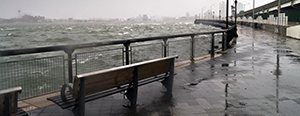 The resiliency of New York City is widely known, as the city has been forced to endure more than its fair share of adversity. Each disaster that challenged New Yorkers, however, seems to only make them come back stronger. The Category 3 hurricane in 2012, known as Hurricane Sandy, was the second-costliest hurricane in United States history. The city was most severely impacted due to its extensive network of below-grade infrastructure. Sandy took its toll on subways, tunnels, and coastal structures. During the height of the storm, the Hudson River breached the esplanade, quickly spreading through the adjoining streets and flooding nearby buildings.
The resiliency of New York City is widely known, as the city has been forced to endure more than its fair share of adversity. Each disaster that challenged New Yorkers, however, seems to only make them come back stronger. The Category 3 hurricane in 2012, known as Hurricane Sandy, was the second-costliest hurricane in United States history. The city was most severely impacted due to its extensive network of below-grade infrastructure. Sandy took its toll on subways, tunnels, and coastal structures. During the height of the storm, the Hudson River breached the esplanade, quickly spreading through the adjoining streets and flooding nearby buildings.
Once the flood waters had receded, businesses and home owners had to repair, rebuild, and come back stronger. Mitigating the damage that the flood waters could do, even after penetrating a building through doorways and windows, was at the forefront of planning for one building that contained a critical server farm severely damaged during the flooding.
The building’s owners contacted the structural engineering firm Weidlinger Associates and WSP Flack + Kurtz to create a solution that would protect the critical machinery in the pump room. The designers worked with Gregory Maugeri of New England Dry Concrete, a waterproofing consultant and distribution partner of Kryton International to come up with a solution to protect the vital systems.
T he idea was to surround critical systems with waterproof concrete walls made with Kryton’s Krystol Internal Membrane (KIM) added to the concrete mix. KIM is a chemical admixture added to fresh concrete to reduce the permeability of concrete and provide permanent waterproof protection. When added to the concrete mix, KIM’s chemicals grow millions of needle-like crystals throughout the concrete matrix, blocking the movement of water in all directions. These crystals remain dormant throughout the life of the structure until they have contact with incoming water, which forms more crystals, blocking the water from penetrating and maintaining a watertight seal.
he idea was to surround critical systems with waterproof concrete walls made with Kryton’s Krystol Internal Membrane (KIM) added to the concrete mix. KIM is a chemical admixture added to fresh concrete to reduce the permeability of concrete and provide permanent waterproof protection. When added to the concrete mix, KIM’s chemicals grow millions of needle-like crystals throughout the concrete matrix, blocking the movement of water in all directions. These crystals remain dormant throughout the life of the structure until they have contact with incoming water, which forms more crystals, blocking the water from penetrating and maintaining a watertight seal.
Also, the concrete-to-concrete joints of the walls used Kryton’s Krystol Waterstop System, which incorporates two cementitious, Krystol-based products. These products react with water the same way as KIM, giving the structure extra waterproofing protection along the concrete joints. Also, because the system uses a proprietary integral crystalline waterproofing formula, it has the ability to self-seal small cracks that may develop over time.
 To provide extra protection, the manufacturer’s T1 & T2 Surface-Applied Waterproofing System was applied to the outside of the walls. This system delivers the crystalline product into the pores and capillaries of the concrete structure as well as providing a physical barrier.
To provide extra protection, the manufacturer’s T1 & T2 Surface-Applied Waterproofing System was applied to the outside of the walls. This system delivers the crystalline product into the pores and capillaries of the concrete structure as well as providing a physical barrier.
The scars of disasters such as this have done their part in altering the landscape of New York permanently, but with the tenacity and strength that New Yorkers have demonstrated – not even disasters such as Hurricane Sandy can hold back growth and innovation.






